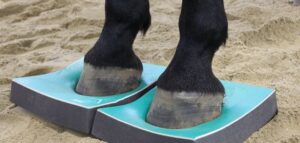Therpeutic exercises and INDIBA: go further.
Published:10 October,2022
Marina Rodriguez Alonso | Veterinarian, master in equine physiotherapy | Global Brand Manager INDIBA Animal Health
Therapeutic exercises are the “cornerstone of rehabilitation”1. Whether they are performed to return to activity after an injury, or if they are used for the physical conditioning of an athlete patient, therapeutic exercises are essential in any rehabilitation and recovery protocol. They are used for a variety of purposes, including improving or restoring joint range of motion, muscle strength, proprioception and balance, weight control, and improving the patient’s overall physical condition. In athletic animals, therapeutic exercises are also used to improve muscle power, speed, agility, and flexibility. There are various types of exercises, and they will depend on the condition of the animal, the type of injury or pathology, the therapeutic purpose and the capacities of the patient (also according to the species) or their guardians. The involvement of the latter is essential for the success of the exercise protocol since many of them will be performed at home.The type of exercises will also depend on the objective at the muscular level and the type of contraction; then there are isometric contractions (the length of the muscle does not vary), concentric (the muscle shortens) and eccentric (the muscle lengthens).The exercises can range from the most basic, such as sitting down and standing up, going up and down stairs/hills, controlled walking or trotting (on a treadmill, on the hand or mounted); to the most complicated ones such as passing cavalletis, dodging cones, walking on different surfaces or balance work with or without the use of tools (holding up a limb, use of balls, peanuts, or balance pads), among others.
They are used for a variety of purposes, including improving or restoring joint range of motion, muscle strength, proprioception and balance, weight control, and improving the patient’s overall physical condition. In athletic animals, therapeutic exercises are also used to improve muscle power, speed, agility, and flexibility. There are various types of exercises, and they will depend on the condition of the animal, the type of injury or pathology, the therapeutic purpose and the capacities of the patient (also according to the species) or their guardians. The involvement of the latter is essential for the success of the exercise protocol since many of them will be performed at home.The type of exercises will also depend on the objective at the muscular level and the type of contraction; then there are isometric contractions (the length of the muscle does not vary), concentric (the muscle shortens) and eccentric (the muscle lengthens).The exercises can range from the most basic, such as sitting down and standing up, going up and down stairs/hills, controlled walking or trotting (on a treadmill, on the hand or mounted); to the most complicated ones such as passing cavalletis, dodging cones, walking on different surfaces or balance work with or without the use of tools (holding up a limb, use of balls, peanuts, or balance pads), among others.
Horse on balance pads.
Regardless of the type of exercise or tool used, the common goal is to improve the animal’s mobility and quality of life. To make these exercises more comfortable to perform and have better results, we can always start with a session of INDIBA.How does INDIBA help in therapeutic exercises?
As we have mentioned on many occasions, the application of INDIBA’s 448 kHz radiofrequency generates specific effects in the tissues: pain reduction, improvement of blood flow, improvement of tissue flexibility, and reduction of repair time. All these effects will also be beneficial when performing the exercises.- By controlling the pain, the patient will have a better disposition to perform the exercises.
- A better blood supply brings oxygen and nutrients to the muscle, so its functioning will be more adequate. In addition, we improve lymphatic drainage and with it waste substances, preventing their accumulation after the exercise.
- By increasing flexibility, we also increase the range of motion. With this, the animal will feel more comfortable performing exercises that require a wide joint range or greater elongation.
- By reducing tissue repair time, we also help advance the type of exercises performed and thereby shorten total recovery time.
References:
- Drum, M. al. Principles and applications of therapeutic exercises for small animals. 2015. Available online: https://pubmed.ncbi.nlm.nih.gov/25432682/
- Minguell Martín. Manual de Fisioterapia en Pequeños Animales. 2014.
- Carroza, A. Therapeutic exercises for every veterinary patient. 2019. Available online: https://www.dvm360.com/view/therapeutic-exercises-every-veterinary-patient
- Exercise Therapy for Horses. 2022. Available online: https://thehorse.com/1115598/exercise-therapy-for-horses/